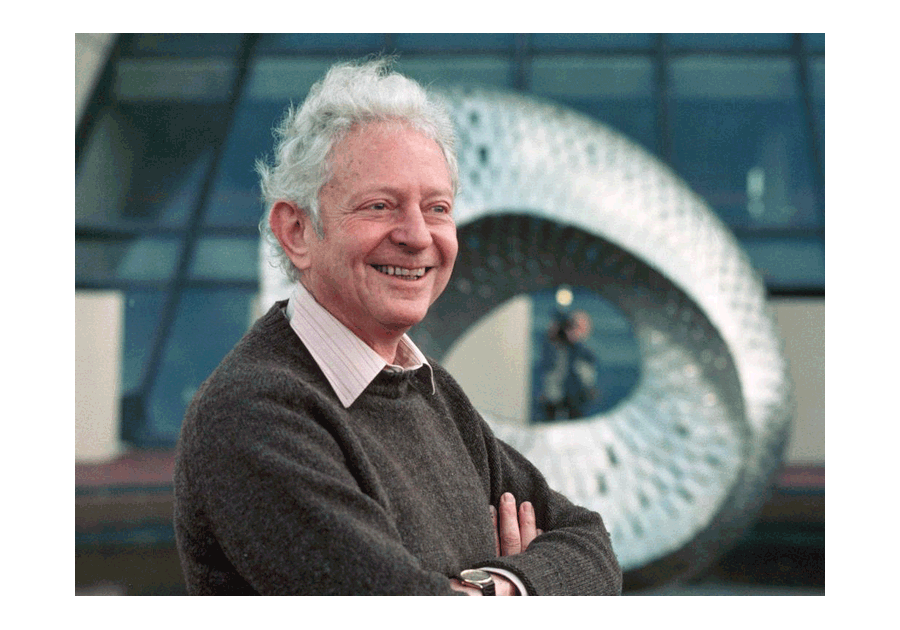
Leon Lederman, a trail-blazing researcher with a passion for science education who served as Fermilab’s director from 1978 to 1989 and was a recipient of the Nobel Prize for discovery of the muon neutrino, died peacefully October 3 at a nursing home in Rexburg, Idaho. He was 96.
He is survived by his wife of 37 years, Ellen, and three children, Rena, Jesse and Rachel, from his first wife, Florence Gordon.
With a career that spanned more than 60 years, Lederman became one of the most important figures in the history of particle physics. He was responsible for several breakthrough discoveries, uncovering new particles that elevated our understanding of the fundamental universe. But perhaps his most critical achievements were his influence on the field and his efforts to improve science education.
“Leon Lederman provided the scientific vision that allowed Fermilab to remain on the cutting edge of technology for more than 40 years,” said Nigel Lockyer, the laboratory’s current director. “Leon’s leadership helped to shape the field of particle physics, designing, building and operating the Tevatron and positioning the laboratory to become a world leader in accelerator and neutrino science. Today, we continue to develop and build the next generation of particle accelerators and detectors and help to advance physics globally. Leon had an immeasurable impact on the evolution of our laboratory and our commitment to future generations of scientists, and his legacy will live on in our daily work and our outreach efforts.”
Through Lederman’s early award-winning work, he rose to prominence as a researcher and began to influence science policy. In the early 1960s, he proposed the idea for the National Accelerator Laboratory, which eventually became Fermi National Accelerator Laboratory (Fermilab). He worked with laboratory founder Robert R. Wilson to establish a community of users, credentialed individuals from around the world who could use the facilities and join experimental collaborations.
According to Fermilab scientist Alvin Tollestrup, who worked with Lederman for more than 40 years, Lederman’s success was in part due to his ability to bring people together and get them to work cohesively.
“One of his greatest skills was getting good people to work with him,” Tollestrup said. “He wasn’t selfish about his ideas. What he accomplished came about from his ability to put together a great team.”
Lederman began his tenure as Fermilab director in 1978, at a time when both the laboratory staff and the greater particle physics community were deeply divided. As a charismatic leader and a respected researcher, Lederman unified the Fermilab staff and rallied the U.S. particle physics community around the idea of building a proton-antiproton collider. Originally called the energy doubler, the particle accelerator eventually became the Tevatron, the world’s highest-energy particle collider from 1983 until 2010.
The advancement of particle accelerators continued to spur discoveries. At Brookhaven in 1965, Lederman and his team found the first antinucleus in the form of antideuteron — an antiproton and an antineutron. In 1977, at Fermilab, Lederman led the team that discovered the bottom quark, at the time the first of a suspected new family of heavy particles.
“All of those experiments were important because they set the stage for learning that we have at least two generations of leptons and something else,” Tollestrup said.”
Lederman served as director of Fermilab from 1978 to 1989. During his tenure as laboratory director, Lederman had a significant impact on laboratory culture. He was responsible for establishing new amenities that set Fermilab apart from other labs, such as the first daycare facility at a Department of Energy national laboratory and an art gallery that continues to host rotating exhibits.
He had significant impact on the next generation of scientists. It was during his years at Columbia, an institution that required students to teach, that Lederman developed a passion for science education and outreach, which became a theme throughout his career. Between 1951 and 1978 he mentored 50 Ph.D. students. He liked to joke about their success, saying that not a single one was in jail.
As director of Fermilab, Lederman established the ongoing Saturday Morning Physics program, which has attracted students from around the Chicago areas for decades to learn more about particle physics from experts, originally from Lederman, and then a long list of leading scientists. The program has inspired generations of high school students.
Recognizing the need for more focused education in science and math, Lederman focused on creating learning spaces and opportunities for students. In the early 1980s, Lederman worked with members of the Illinois state government to start the Illinois Math and Science Academy, which was founded in 1985, and worked with officials to try to adjust the science curriculum in Chicago’s public schools so that students learned physics first, forming the foundation for their future scientific education. He founded and was chairman of the Teachers Academy for Mathematics and Science and was active in the professional development of primary school teachers in Chicago. He also helped to found the nonprofit Fermilab Friends for Science Education, a national leading organization in precollege science education.
—Fermilab

